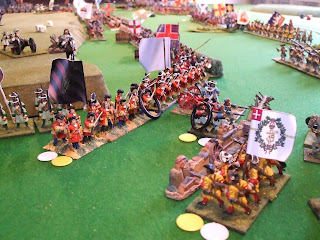Last week the game was left with the point of decision being on the Jacobite right, where St Ruth was attempting to halt an advance by the Dutch and Danish infantry and cavalry. The second evening began with Sarsfield leading forward his last unit of cavalry in a desperate attempt to buy time for reinforcements to arrive. Sarsfield prevailed in the ensuing melee and rather recklessly pursued the defeated Dutch horse. This resulted in the disordered Jacobites being caught by fresh cavalry and pursuit turned into rout as the remnants of Sarsfield's men tumbled from the field.
Undaunted by this reverse, the cavalry commander turned to the cavalry reserve released by St Ruth and led that forward. Again he suffered defeat, and had to turn to the final reserve which had been moved from the left flank. Meanwhile the fire fight continued between the grenadiers defending the right flank and the guards battalions attacking them. Heavy losses were suffered by both sides and soon only a few companies of powder-stained infantry remained with the colours. The restricted front made it difficult for the Williamites to reinforce or extend the line, unlike the Jacobites , who benefited from the arrival of battalions from Lord Bellew's and the Grand Prior's regiments, who moved up on the right of the grenadiers. An attempt by Ginkel to extend the line to the right, by moving Von Bulow's regiment forward was met by volleys from the 1st battalion of the Irish Guards who had been given the 'honour' of defending this 'knuckle' in the defence line.
Further along the line, the Jacobites continued to delay the advance by the English and Hugenot infantry and the left of the Jacobite line seemed secure from any advance. To St Ruth the threat still lay on his right and here events were to take a dramatic turn for the worse.
The repulse of the Jacobite cavalry had allowed the Williamite cavalry to advance and deploy on a wider front. This gave the Jurl regiment the freedom to deploy facing the flank of the Jacobite infantry line. With their attention occupied by the infantry to their front, the men of Lord Bellew's regiment did not see the cavalry bearing down on them until it was too late to reform to meet the threat. Already reduced in numbers by their fire fight with the Danish guards the Jacobite infantry did not stand, but turned and routed back up the hill towards the centre of St Ruth's position. Sensing an opportunity, the colonel of the Jurl regiment urged on his men towards the flank of the next infantry unit. This unit, the Grand Prior's regiment although fresh to action refused to stand when they saw colleagues routing past them. Eventually the cavalry reined in at a fence blocking their path, in a few minutes they had destroyed the right flank of the Jacobite position. The grenadiers, having stoutly stood their ground against heavy odds were demoralised by the sight of their supports routing away and also routed. The 1st Battalion of the Guards were also forced into retreat by the flood of routers.
St Ruth hurriedly stripped yet more units from the 'quiet' sectors to cobble together a new line behind which he hoped to rally the fleeing units. The second battalion of the Guards was ordered forward to fill the gap left by the first. Stout work was done by the artillery, virtually the only unit on the Jacobite right to stand their ground. They worked like demons firing as fast as they could at the advancing infantry. However, they stood too long and as the infantry came in range their volleys quickly began to inflict casualties. The rate of fire began to fall and soon there were too few to man the guns and the pitifully few survivors fell back.
Sarsfield had one last throw of the dice and led forward is final reserve. This met the last uncommitted Williamite cavalry in a fierce melee which involved both brigade commanders. Eventually the Jacobites prevailed, but as the cavalry regrouped they found the body of Sarsfield amongst a group of dead enemy horsemen. The Williamite cavalry were destroyed, but the Jacobite cavalry were too few in number to operate as a viable threat to the Williamite infantry, so they formed up and slowly gave ground in front of a cautious enemy advance.
Elsewhere the English and Hugenots had taken advantage of the thinning of the Jacobite lines to move forward and in some places had reached the main defence line. Uncertainty about events on the flanks caused some wavering in the infantry units and anxious glances over the shoulder were not eased by increasingly strident commands to 'look to your front' The grenadiers attached to the Hugenot brigade had attacked the second battalion of the Irish Guards as they attempted to hold the 'knuckle' and in a fierce melee forced the Irishmen to give ground. As these elite troops grudgingly fell back St Ruth realised that the day was lost and the best strategy was to preserve as much of the army as possible for the next battle.
Taking advantage of the gathering gloom and the weariness of the Williamite forces the Jacobites began to retreat down the road towards Galway.
Musket rests
3 hours ago




Excellent report, very enjoyable!
ReplyDelete